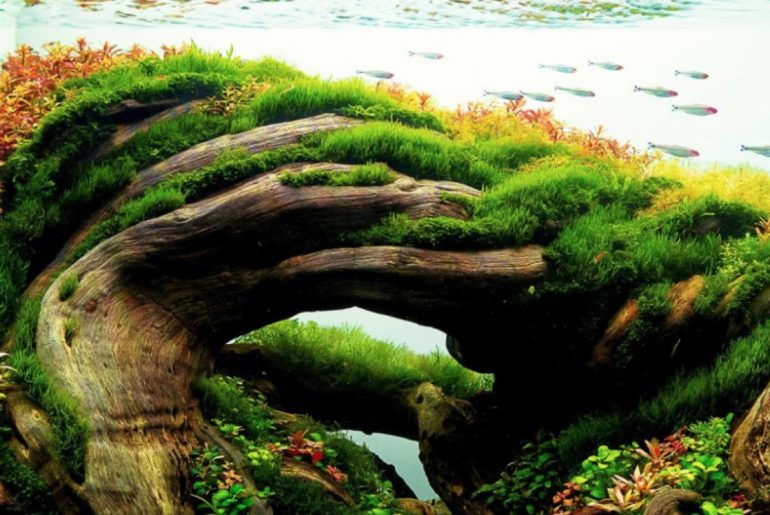A natural aquarium is a special eye-catcher and makes the hearts of many aquarists beat faster. Anyone considering setting up a natural aquarium should not miss this article: Here you can find out exactly what a natural aquarium is, how you set it up, which aquarium plants are suitable and how it differs from other types of aquarium design.
What is a nature aquarium?
In the natural aquarium, the impression of a natural scenery is created without replicating it in detail. Plants, roots and stones create an overall picture in which the viewer can lose himself, just like in nature. There is room for playing with structures, contrasts, colours, shapes, light and shadow. Natural elements such as roots or stones are used for decoration. The main focus of the natural aquarium is on the planting.
Typical for a natural aquarium
- Plants play the leading role
- Lots of free space
- Plain rear panel (single color film)
- Natural decoration materials
- Play with light and shadow
Natural aquarium and other aquarium types in comparison
Biotope aquarium
The term natural aquarium is often equated with biotope aquarium. However, the natural aquarium is about creating a natural scenery. A biotope aquarium, on the other hand, is a tank in which the natural habitat of an animal species is faithfully reproduced. A biotope aquarium can replicate the underwater world of Lake Malawi in Africa, or a South American mangrove area. From the selection of the plants to the substrate, the decorative materials and other furnishings such as leaves lying on the floor, everything in the biotope aquarium is adapted to this. Of course, the water values and other environmental parameters are also included – just like the right stocking.
Japanese natural aquarium according to Takashi Amano
A name that usually comes up in connection with the topic of nature aquariums is Takashi Amano. The Japanese has decisively shaped the aquarium scene and is not only considered the father of natural aquariums, but also of the aquascaping scene, which later developed from it. His cymbal layouts became groundbreaking. The terms Japanese aquarium or Japanese natural aquarium have therefore also become commonplace for the term natural aquarium.
Aquascape
Designing a natural aquarium is closely related to aquascaping. However, it is not the same thing. The term aquascaping is short for “acquatic landscaping”, which means something like “designing underwater landscapes”. Here landscapes from nature (above water) are reproduced. This can be a mountain landscape, a steppe, a hilly landscape covered with vegetation and much more. In aquascaping, mountains, hills, trees or entire forests are often created underwater in miniature format, which is less common in natural aquariums.
In the natural aquarium, on the other hand, there are no detailed “imitations”. It’s more about giving the impression of naturalness, drawing the viewer into the landscape and inviting him, like in nature, to let his gaze wander freely. Anyone who looks at the aquarium, for example, gets the impression of a wild thicket like in a forest – but without individual trees being reproduced as in aquascaping.
Naturaquarium
Impression of naturalness, rather low degree of realism — the overall impression is decisive. The viewer can freely interpret the landscape.
Aquascaping
High degree of realism, individual landscape elements are reworked in detail.
In a Dutch aquarium or Holland aquarium, plants play the main role – just like in a natural aquarium. However, the plants are used here in such a way that clear structures are formed, comparable to flower beds in the garden. The Holland Aquarium works with color contrasts and leaf structures, with geometric shapes such as lines or triangles.
In contrast to natural aquariums, Holland aquariums appear more structured and well planned when compared to a natural aquarium. Which design principle is preferred depends of course on your own preferences and individual taste.
Which plants for the natural aquarium?
One thing is clear: plants play the main role in the natural aquarium. But which plants are particularly suitable for planting in a natural aquarium?
Choosing the right plants for the natural aquarium
Of course, choosing the right plants depends on your own taste. However, there are some aquarium plants that are particularly suitable for setting up a natural aquarium because of their growth habit or other properties. Because it is by no means a question of simply using aquarium plants and letting them grow wild, as in nature. It is planned very precisely how natural scenes can be created with a selection of plants. How detailed you want to proceed is entirely up to you. Or maybe you just let yourself be inspired by some beautiful nature aquarium layouts for the design of your aquarium.
Nature Aquarium: Plants for the foreground
Plants that form a lawn in the aquarium are popular for the foreground in the natural aquarium. Depending on the size of the aquarium, grassy aquarium plants, such as New Zealand grass, form focal points for the eye or provide ground cover for the foreground and side areas of the tank. Lawn-forming aquarium plants also have the advantage of providing support for a mound structure in the aquarium when they root through the soil. Glossostigma is one of the aquatic plants that are used particularly frequently in natural aquariums. Overall, you have a wide selection of foreground plants for the aquarium.
Nature Aquarium: Plants for the middle ground
Which plants are suitable for the middle ground in a natural aquarium depends on various factors. Consider:
Planned pelvic layout: Should the central pelvic area have a generous amount of free space? Are you planning a “plant island” as an eye-catcher in the middle of the pool? Are roots or larger stone structures planned? Depending on how you answer these questions, you should choose background plants, pretty midground plants or epiphytes.
Aquarium Size: Find out what size the mature plants will be. Of course, completely different aquarium plants are suitable for the middle ground in a nano aquarium than for the middle area in a tank that holds several hundred liters.
Type of planting or attachment: should the plants be planted directly in the substrate, or would you like to attach epiphytes?
Nature aquarium: plants for the background
In many natural aquariums, the background is not planted. Instead, tall plants are used on the side or in the center of the pool. There are various reasons for this:
Optical depth: The impression of optical depth plays an important role in the natural aquarium. Therefore, a decorative or planted rear wall is not used. A black or milky film is usually used. Aquarium plants in the background of the tank can disturb the impression of depth. In the lateral areas, however, they are in very good hands.
Points of focus in the tank: In the natural aquarium there is often a focal point to which the observer’s gaze is drawn. Dense planting in the background would disturb this impression. However, background plants are ideal for creating this focal point – for example as a green island of plants in the middle of the aquarium.
Natural aquarium: Epiphytes
Epiphytes are a real must in a natural aquarium. They are the first choice to reinforce the natural impression. You should definitely green roots and stones with epiphytic plants in your natural aquarium if this suits your planned tank layout. This way, the decorative objects immediately appear much more lifelike. Just think of the difference between a root with and without moss planting.
We can particularly recommend moss for the aquarium: it gives the design filigree details. Moss for the aquarium is also ideal for greening stones, roots or even the substrate. Beautiful layouts can also be created with other classic epiphytes, such as Java fern or Anubias.
Tip: You can find out how to attach epiphytes in our article here on the blog.
We hope you enjoy choosing the right plants for the natural aquarium!





